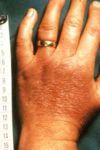Borrelia afzelii
Classification
Higher Order Taxa
Kingdom: Bacteria, Phylum: Spirochaetes, Class: Spriochaetes, Order: Spirochaetales, Family: Spirochaetaceae, Genus: Borrelia
Species
Borrelia burgdorferi, Borrelia lonestari, Borrelia recurrentis
Description and Significance
Borrelia afzelli is considered a new species of the Genus Borrelia and considered homologous to Borrelia burgdorferi with regard to phenotypic, genetic, and immunological characteristics. Diseases linked to this species of Borrelia are Lyme disease and Acrodermatitis chronica atrophicans (ACA). Better understanding of the structure and function of this pathogen will create better methods of treatment to people with the diseases it causes.
Genome Structure
The genome sequencing of this particular strain is still underway as it is still a very new strain. However, all previous species of Borrelia have had linear chromosomes, ranging in sizes from 900-920kb pairs and have circular and linear plasmids. Also, it is thought that the strain B. afzelii has recently been derived from B. burgdorferi due to its lack of genetic variance. The genome of the bacterium Borrelia burgdorferi has a linear chromosome of 910,725 base pairs and at least 17 linear and circular plasmids.
Cell Structure and Metabolism
Borrelia spirochetes are 5 to 25 µm long and 0.2 to 0.5 µm wide. The species afzelli is a motile, nonsporulating, spirally-shaped, aerobic, pathogen. Also, it is a gram-negative bacterium and is generally transmitted through ticks. The bacterium has very specific nutritional needs and lives by regulating the lipoproteins within the host.
http://www.microbelibrary.org/images/jnelson/images/borrelia.jpg
Ecology
Borrelia resides in the digestive tract of the tick or flea. The tick or flea usually inherits the bacteria from an infected, white-footed mouse. Once the tick has acquired the bacteria it is the host and can now be the transmitter of the disease human Lyme borreliosis (LB). Since the tick lives by sucking the blood of its victim, the bacteria is transmitted through saliva by a bite of its victim.
Pathology
The most prevalent arthropod-borne infection in temperate climate zones around the world caused by Borrelia spirochetes is Human Lyme borreliosis (LB). LB is attained mainly by the transmition of Borrelia in the saliva of the bite of a tick or flea. In order for the bite to be infectious, the tick first must contain the bacteria within the lumen of its stomach. Being spirally-shaped allows it to penetrate deep into its hosts avoiding recognition of an immune response. B. afzelii itself causes a distinct skin infection known as acrodermatitis chronica atrophicans (ACA). ACA is seen in the late stage of LB and can be diagnosed as, progressive, fibrosing skin process due to continuing infection of the bacterium. It is followed by an inflammatory stage with bluish red discoloration and cutaneous swelling, often seen with recurring events even a year after first notice. The early stages of LB can be noticed by a bulls-eye like marking on the surface of the skin, most notably on the extremities. Additionally, it can be noted by symptoms such as fever, fatigue, headache, muscle aches, and joint aches.
http://www.novatec-id.com/blot/clinical_aspects_en.htm#aca http://www.afraidtoask.com/lyme/lymelifecycle.html
Current Research
Current research of B. afzelii includes observing the cell-mediated immune response in recognition of the bacteria. Illnesses cannot always be successfully recognized. This lack of identification is due to the incomplete knowledge of the specific and non-specific host responses caused by the spirochete antigenic structures. It is because of this lack of knowledge of the structure that major attention has been drawn to better comprehend its structure.
References
Blackwell Synergy - FEMS Immunol Med Microbiology, Volume 28 Issue 3 Page 233Issue 3 - 240 - July 2000
Can it be Lyme Disease?---HealthandAge
eMedicine - Acrodermatitis Chronica Atrophicans: Article by Bozena Chodynicka, MD.
Genomic Sequence of a Lyme Disease spirochaete, Borrelia burgdorferi.
Jason Farlow, Danielle Postic, Kimothy L. Smith, Zack Jay, Guy Baranton, and Paul Keim Department of Biological Sciences, Northern Arizona University, Flagstaff, Arizona 86011-5640, Institut Pasteur, Paris, France Received 12 February 2002/ Returned for modification 31 March 2002/ Accepted 2 September 2002
Journal of Clinical Microbiology, December 2002, p. 4612-4618, Vol. 40, No. 12
MB451 Spirochaete Lecture
Microbial Taxonomy Last revised: Monday, March 31, 2003 Reading: Ch. 17 in text: for further details, see Microbial Diversity class notes from N. C. State Univ.
ScienceDirect - FEMS Microbiology Letters: Homogeneity of Borrelia japonica and heterogeneity of Borrelia afzelii and ‘Borrelia tanukii' isolated in Japan, determined from ospC gene sequences.
The Lyme Disease Guide: Tick Life Cycle
Toshiyuki Masuzawa*, Tetsuro Komikado, Kazuhide Kaneda, Takako Fukui, Katsuji Sawaki and Yasutake Yanagihara Department of Microbiology, School of Pharmaceutical Sciences, University of Shizuoka, 52-1 Yada, Shizuoka, Shizuoka 422, Japan Received 15 April 1997; revised 21 May 1997; accepted 28 May 1997. Available online 7 November 1997.



